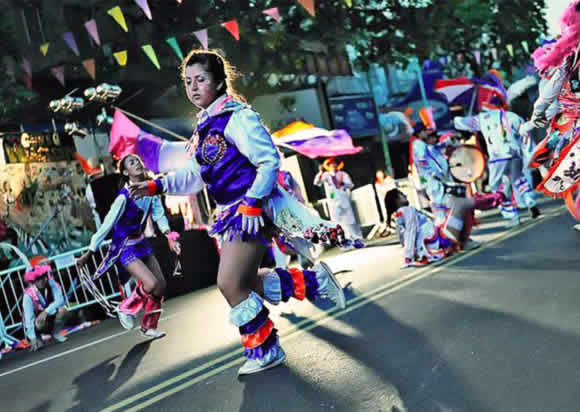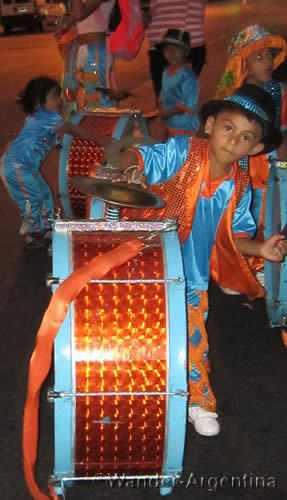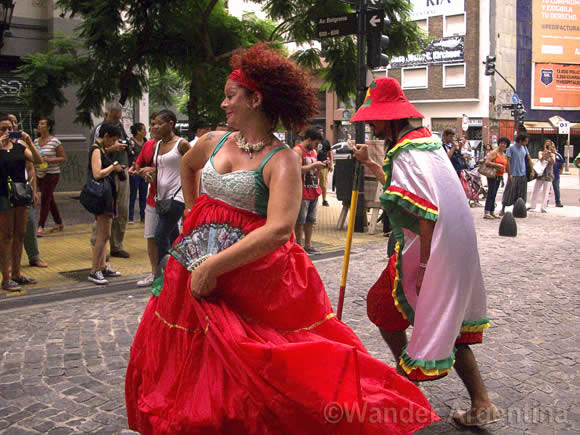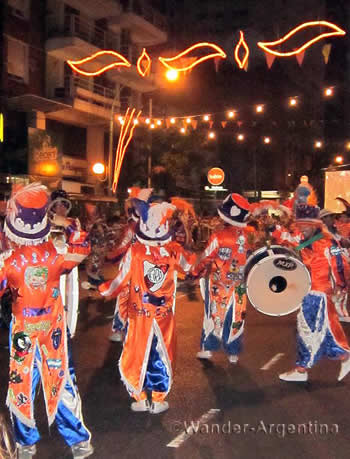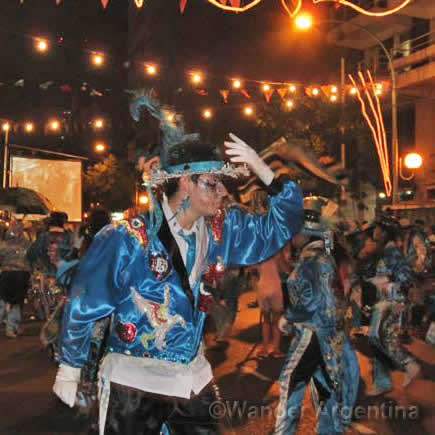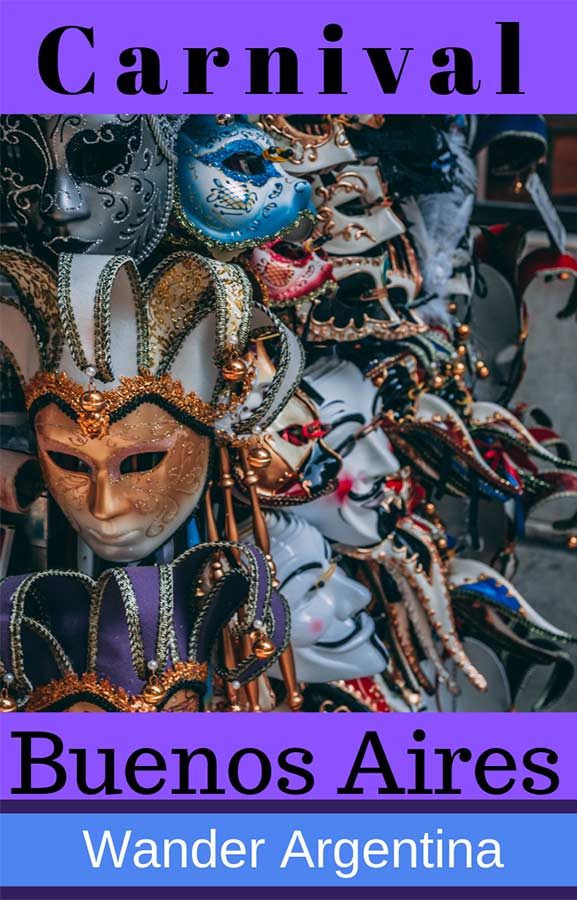Carnival does not just happen in Brazil’s Rio de Janeiro or Argentina’s Gualeguaychú.
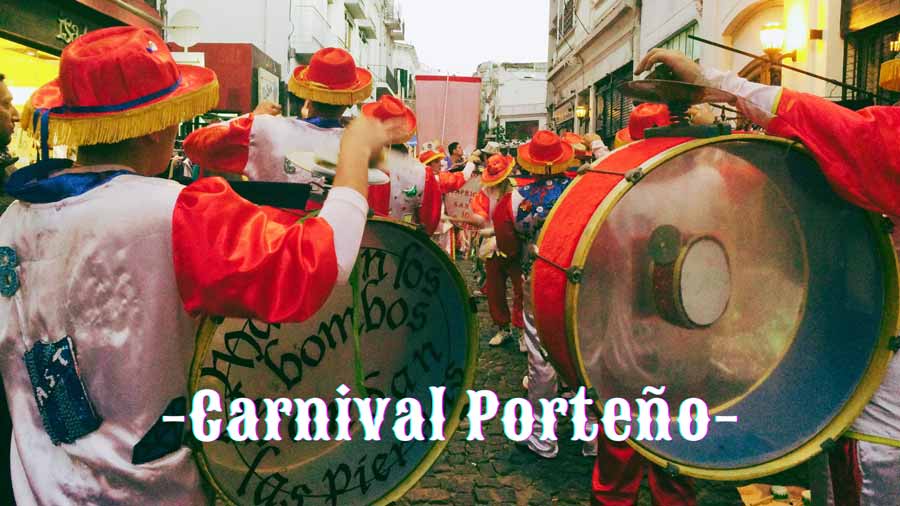
For anyone who’s missed the boat — or bus — to the bigger carnivals, or can’t be torn away from the city’s hustle, Carnaval Porteño (Buenos Aires’ Carnival) is back and better than ever.
Normally, the free festivities take place on Saturdays and Sundays all through February, as well as on Carnival holidays which fall early in the month this year on February 12 and 13.
→ Going to Brazil instead? Book tickets to the Samba Parade at Carnival in Rio de Janeiro
Murgas: The Basics of Buenos Aires’ Carnival
Dozens of barrios (neighborhoods) in the city have their own celebrations, with over 100 murgas (bands of marching percussionists and dancers) taking to the streets.
What’s different about Buenos Aires’ carnival is that it isn’t one long parade.
The action happens within the confines of 35 gated-off street sections around the city.
This has the benefit of dispersing the crowds so no one is stuck way out straining their neck to see who’s banging which drum.
The celebrations may be less grandiose than other South American carnivals, but the party spirit is by no means lacking.
Each Buenos Aires’ murga carries an often silly or self-deprecating name that includes its home barrio, such as:
‘Los Chiflados de Boedo‘ (The Crazies of Boedo);
Los Viciouso de Almagro (The Vicious of Almagro);
‘Los Audaces of Bajo Belgrano‘ (The Audacious of Lower Belgrano);
‘Los fantoches de Villa Urquiza‘ (The Loud-Mouths of Villa Urquiza);
and one of the city’s largest murgas, ‘Los Amantes de La Boca‘ (The Lovers of La Boca).
What is a Carnival Murga?
Murga music is protagonized by the bombo con platillo, a special type of drum with a cymbal, originally brought to Argentina by Spanish immigrants.
A pumping beat provides backing for murgueros (participants in the murga) who sing, dance and wave flags with a festive mix of artistic and political expression.
As if the drums aren’t enough to burst all eardrums in the vicinity, deafening chants are bellowed above the hubbub.
Content ranges from group introductions to political messages called ‘críticas’ — only the finest-tuned Argentine Spanish ears can tell the difference.
The best murgas preserve the tradition of the ‘critica,’ which are provocative political messages that question those in power.
Colorful Costumes
With an approach to brightness and color similar to a two-year-old let loose on the paints, brilliantly decorated faces grin at the crowds.
Costumes, consisting of a suit, gloves, top hat and cane, are lovingly embroidered for months before carnival season by a host of murguero mothers.
At the show, the shiny, sparkling results swish along so fast it’s hard to see where one sequined hat ends and the other begins.
A sea of onlookers get down to the beat, feet tapping with impeccable Latin timing whilst gaggles of small children spray each other, and everyone else in range, with canned foam.
Giggling adolescents join in, using their aerosols to flirt with school friends.
View this post on Instagram
History of Carnival in Buenos Aires
The Argentine carnival tradition grew at the end of the 18th century when a mix of immigrants used dance and song as a way to express disenchantment with their social situation.
The subsequent murgas that sprang from this ‘breaking of the chains’ typically involved the working classes and were used as a way to laugh at those in power.
The attire worn in Carnaval Porteño, with the top hat and suit get-up, originated from free slaves poking fun at their previous masters.
Originally murgas tended to be ethnically divided.
Freed African slaves and their descendants would have a separate murga from Italians or Galicians.
This changed in the 1930s when murgas began to form by neighborhoods rather than nationalities or religion and became a unifying force among he more modest classes.
Modern Murgas
These days, murgas — still highly politically charged — are a way for communities to come together to express themselves.
Each group has its own name and costume linked to its barrio (many murgas are connected to the government, while others choose to be independent).
Groups can be found practicing in their barrio’s main squares during the year and neighbors often come along for some light entertainment and some heavy drumming.
Gustavo Arcangelo, a 29-year-old independent murga member describes the variety of people in his group ‘Espíritu Cascabelero de Lanús’:
“Last year there were some pregnant girls in our group, so this year they’ve brought their five or six-month-old babies.
Our oldest member is 40. Everyone dances together, we don’t discriminate, after all, we all travel to the murgas on the same bus.”
Carnaval murgas in Buenos Aires haven’t always been as inclusive.
In the past women weren’t allowed to dance with men, and were not permitted to wear the same clothes.
During the military dictatorship of 1976—983 it looked as if the carnival spirit was about to be stamped out forever.
The traditional two-day holiday was annulled and although murgas weren’t expressly forbidden, it was almost impossible for them to continue.
They were only allowed to take place in closed areas, and people had to pay to enter.
“They stole the feeling of murgas by making profit out of them,” says Arcangelo, of the murgas during the dictatorship.
Murga Democracy & Rock & Roll
A return to democracy brought about a carnival revival. Workshops and courses were introduced to teach people how to be murgueros.
This helped to expand the murga tradition and include those who previously weren’t involved, such as women and the middle classes.
Argentine rock and roll Gods also propelled carnival into popular culture with murga-influenced rhythms in songs such as ‘El Murguero’ by Los Autenticos Decadentes; ‘Verano de 92′ by Los Piojos and ‘Carnaval Todo la Vida’ by Los Fabulosos Cadillacs.
Carnival Holidays and Cultural Heritage
Bringing this style of music to the masses worked — in 1997 murgas were given ‘Cultural Heritage’ status by the City of Buenos Aires.
Today, a million and a half people in Buenos Aires take to the streets to enjoy the festivities.
Ex-president and vice-president Cristina Kirchner— who was never one to turn down an excuse for a holiday — reinstated the two-day carnival holiday nationwide in 2011, making the end of Carnival a four-day long weekend — the first holiday since the start of the year.
While many residents take short trips away from the city, many stay for the murgas.
It’s safe to say that the spirit of carnival is working its way back into the mainstream and while the drum and crowd-averse may disagree, carnival-lovers feel this acceptance is yet more cause for celebration.
“Although there are bad things in the world, the murga shows that you always have to keep going, keep fighting, express yourself and tell the world that you want change,” says murguero Arcangelo.
“And of course, put on a bit of color.”
So grab the face paints, get those feet tapping and take to the streets to join in the fun.
— by Rosie Hilder
Carnival Buenos Aires 2024
Carnival is all through February with the Carnival long weekend falling on Monday, February 12, and Tuesday, 13
